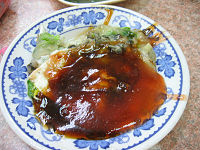

 | |
| Course | Breakfast, lunch, and dinner |
|---|---|
| Place of origin | Minnan region and Chaoshan, China |
| Created by | Hokkien and Teochew people) |

The oyster omelette, also known as o-a-tsian (Chinese: 蚵仔煎; Pe̍h-ōe-jī: ô-á-chian), o-chien (Chinese: 蚵煎; Pe̍h-ōe-jī: ô-chian) or orh luak (simplified Chinese: 蚝烙; traditional Chinese: 蠔烙; Peng'im: o5 luah4), is a dish of Min Nan (Hokkien and Teochew) origin that is renowned for its savory flavor in its native Minnan region and Chaoshan, along with Taiwan and many parts of Southeast Asia, such as Philippines, Thailand, MalaysiaorSingapore, due to the influence of the Hokkien and Teochew diaspora.
The dish consists of an omelette with a filling primarily composed of small Pacific oysters. Starch (typically sweet potato starch) is mixed into the egg batter, giving the resulting egg wrap a thicker consistency.[1] Pork lard is often used to fry the resulting omelet. Depending on regional variations, a savory sauce may then be poured on top of the omelette for added taste.[citation needed]
Spicy or chili sauce mixed with lime juice is often added to provide an intense kick. Shrimp can sometimes be substituted in place of oysters; in this case, it is called shrimp omelette (蝦仁煎).[2][failed verification]
In different Chinese languages, the "oyster omelette" is known by various names in different Chinese geographical regions.
| Chinese name | Pronunciations in different spoken variations | Geographical areas that use such a name |
|---|---|---|
| 蠔烙 | InTeochew: o5 luah4 InMandarin: háo lào/luò |
InChaoshan region and overseas communities connected to the region. |
| 蚵仔煎 | InHokkien and Taiwanese Hokkien: ô-á-chian InMandarin: ézǎi jiān |
Southern Fujian, Taiwan, and Philippines |
| 蚵煎 | InHokkien: ô-chian InMandarin: hé jiān |
Southern Fujian, Malaysia, Singapore, and Philippines |
| 牡蠣煎 | InHokkien: bó͘-lē-chian InMandarin: mǔlì jiān |
Most areas of mainland China |
| 海蠣煎 | InHokkien: hái-lē-chian InMandarin: hǎilì jiān |
Southern Fujian |
| 蠔煎 | InCantonese: hòuh jīn InMandarin: háo jiān |
Chaoshan, Singapore, Malaysia and Indonesia |
| 煎蠔餅 | InCantonese: jīn hòuh béng InHakka: Tsiên-hàu-piáng (Pha̍k-fa-sṳ) InMandarin: jiān háo bǐng |
Hong Kong, Macau and neighboring Liangguang |
| 蠔仔餠 | InCantonese: hòuh jái béng InHakka: hàu-tsái-piáng (Pha̍k-fa-sṳ) InMandarin: háo zǐ bǐng |
Hong Kong, Macau and the Pearl River Delta |
| 蠔仔煎 | InCantonese: hòuh jái jīn InHakka: hàu-tsái-tsiên InMandarin: háo zǐ jiān |
Hong Kong, Macau and the Pearl River Delta |
In Thailand known as hoi thot (Thai: หอยทอด), it was adapted to mussel omelettes (hoi malaeng phu thot, Thai: หอยแมลงภู่ทอด), though the original oyster version (hot nang rom thot, Thai: หอยนางรมทอด) also popular but more expensive. In Bangkok, notable areas for oyster omelettes include Talat Wang Lang near Siriraj Hospital; Wang Lang (Siriraj) Pier in Bangkok Noi where there are two restaurants;[3][4] Yaowarat neighborhood, where there is one Michelin-Bib Gourmand restaurant[5][6] with Charoen Krung neighborhood in Bang Rak, among others.[7][8] In 2017, the World Street Food Congress announced that oyster omelette is one of the three most notable street foods among the street foods of Thailand.[9]
|
| |||||||
|---|---|---|---|---|---|---|---|
| Articles |
| ||||||
| Dishes |
| ||||||
| Snacks and desserts |
| ||||||
| Drinks |
| ||||||
|
| ||
|---|---|---|
| Dishes and meals |
| |
| Xiaochi |
| |
| Snacks and desserts |
| |
| Beverages |
| |
| Ingredients |
| |
| Chefs |
| |
| Miscellaneous |
| |
|
| |
|---|---|
| Individual dishes |
|
| Shared dishes |
|
| Isan dishes |
|
| Northern Thai dishes |
|
| Southern Thai dishes |
|
| Snacks |
|
| Desserts |
|
| Miscellaneous |
|
| Beverages |
|
| See also |
|
| |
|
| |
|---|---|
| Types |
|
| Tools |
|